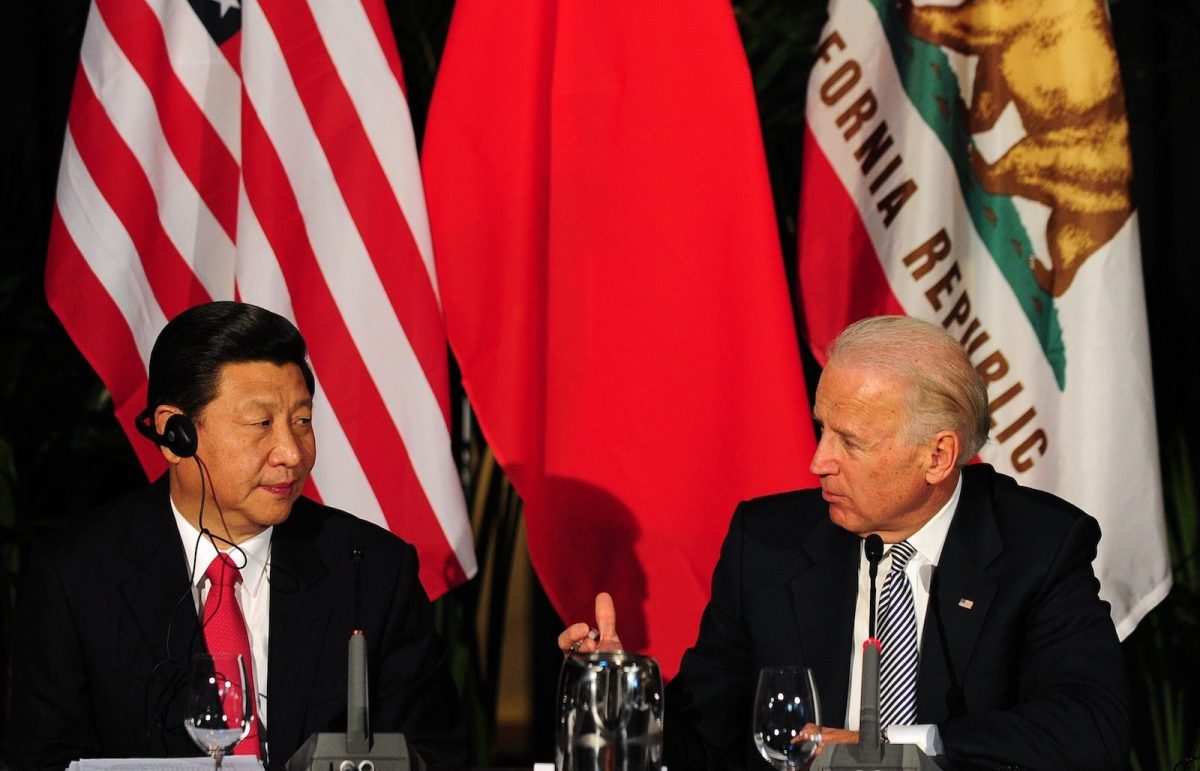[ad_1]
Let’s look at the picture below. This is China now: wishing to be in a futuristic imperial past, or just west of Los Angeles. But where is it actually? And where are the non-Chinese in the Chinese dream?
The picture was taken at Guozijian, the traditional cultural heart of Beijing, a small alley where one can find the old Confucius Temple, where all advanced students came to pray to pass the imperial examinations, and where the names of successful candidates were carved in stone before the hall of the old philosopher.
Then the picture becomes the symbol of what Chinese culture is and wants to be now – something west of Los Angeles (the girl on the right) or boosted into a science fiction future in pseudo-imperial garb (the man on the left). All of this can sound very appealing to America, fascinated by a mish-mash of old tradition and the future and still feeling cut short by the idea that the exploration of the west stopped on its Pacific shores.
But can China still become the latest western projection of America? Time is running out for that, and not only because of China but also because the rest of the world wants to know where to stand – with America, with China, or fending for themselves.
Where is Washington in 2040?
“The Biden administration needs to show it can provide protection for regional allies that are willing to take heat for the US, and that it is not afraid to use all the tools at its disposal, including military power, to push back on Beijing,â€Â argues Lee Seong-hyon in the South China Morning Post.
South Korea feels the immense pressure. It normalized ties with China in the 1990s, egged on by the US, which was then positive on developments in Beijing. Now it is stuck between a rock and a hard place. The US guarantees its security, but its economic growth is largely hooked to China.
Then, whatever it chooses, Seoul has to be sure that the US won’t flip on its head in a couple of years and warm up to China again. In that case, South Korea would suffer the brunt of being considered a “traitor†by China and then suffer Chinese implacable fallout.
A similar and even more complicated issue is with Germany, the largest economy in Europe and the real engine of the EU. Since 2016 and the US “America first†policy, China has become Germany’s main trading partner, and in 2020 they exchanged goods worth 212.1 billion euros.
“The importance of trade with China is framed as a one-sided dependency of Germany on China, which does not match the complexity of the bilateral trading relationship.†as the South China Morning Post wrote.
According to German statistics, German exports to China were €95.8bn and German imports from China €116.2 bn. So, China had a surplus. But according to Chinese customs data, Germany had a surplus. Chinese imports from Germany were $105.2 bn while exports were $86.8 bn.
This would make Germany the only developed country with a surplus with China. Germany also grew its huge trade with China from the mid-1990s, if not encouraged at least unhampered by the US.
This is a fundamental reason that at the end of last year Berlin signed the controversial CAI, the preliminary agreement on investment with China.
Yet still now America urges Germany to cool off with China, and Germany is torn. This is for the common defense of liberal and democratic values, but also because practically German exports to the United States in 2020 were €103.8bn and Germany by its own admission has with the US its largest trade surplus of €36 bn.
In the year of the pandemic, Germany fared very well despite all odds. Its “current account surplus shrank to $261 billion as demand for cars, machinery, and equipment fell in many of its key export markets, the survey showed. Japan came in third with a current account surplus of $158 billion. Measured in relation to economic output, however, Germany’s current account surplus remained unusually high at 6.9% last year, edging down only slightly from 7.1% in 2019.â€
This has an impact on the whole EU as China overtook the United States as the European Union’s biggest trading partner last year, excluding Britain, and reached €586 bn in 2020.
Exports to China are valued at €202.5bn and imports are worth €383.5bn.
Then although the EU doesn’t have South Korea’s grave security anxieties with China, it has a massive economic concern. If the EU economy doesn’t work (the German economy is its main engine), the union itself could unravel and eventually fall apart, starting a massive global financial crisis and creating a geopolitical vacuum where Russia, maybe backed by China or other countries, could step in, wreaking havoc and de facto isolating the US to its own continental shell.
Choices for the US?
In past few days, many articles and essays have been published in America proposing resetting US-China relations on some realistic grounds stopping the present slide to war. One would be to try to revert to finding some broad political and geopolitical goals to work together and thus to rebuild a new trust.
The problem however seems to be that presently both ideology and geopolitical goals drive contention between the US and China. It is not a situation, as the Foreign Affairs article argues, where ideologies and political goals can be split and handled separately, like in the 1970s and 1980s.
Then indeed the US and China had two great overarching common worries: the USSR and Vietnam. Both wanted to contain and possibly break the two countries. In the past two decades, the US and China tried to collaborate in the neighborhood, on North Korea and on Myanmar, but then slowly their goals started differing. On the environment, in the 2009 the Obama administration tried collaborating with China in 2009 but was rebuffed.
In fact, it’s quite the opposite. Presently, ideology could be the veneer under which there are clashes of massive geopolitical interests: from India to Southeast Asia and Taiwan, the technological race, de facto an arms race with electronic characteristics, the currency (the still not fully convertible Chinese RMB), and the infamous Chinese trade surplus.
On this, the present American textbook of “regime change†and color revolution doesn’t work. The US has been bad at “regime change engineering†in Iraq or Afghanistan; the Arab Springs are testament to grave errors. Therefore, political change engineering in China could turn up a mess too. After all, many powerful people in the Party tried to topple President Xi Jinping and failed – why should America succeed now?
Certainly, within China, Xi is succeeding. On February 24 the official Chinese news agency Xinhua reported, “Along the path to zero poverty, Xi made plans and decisions that have changed the fate of millions of Chinese families for the better. The path has been littered with bumps and holes, yet he held on to his original motivation.
In the New Year speech that rang in 2021, Xi said, “Through eight years, under the current standard, China has eradicated extreme poverty for the nearly 100 million rural people affected.
“China has ended the poverty that plagued the country for thousands of years, but it merely marks another beginning – the beginning of more miracles yet to be worked, and a path toward an even brighter future.â€
Perhaps there might also be a positive spin for global tensions in all of this. If Xi did something that was never achieved for millennia, then he wouldn’t need to trifle over the prickly issue of unity with Taiwan or other military inducements.
On the internal front, these results on poverty show that the Chinese people had better stick with Xi and not be lured by vague foreign sirens of democracy and human rights. Xi is good and real in his promises, while the US goes back and forth: four years of “America first†and now four years of “America is back†– and what will the next four years be?
Still, it is no occasion to waver as time is running out. If the US builds a global alliance to confront China, this will shape the world at least for the next 30 years. To prevent this, China should stop in its tracks now, find a suitable excuse for itself, say to the US “we shall be your partner,†and then adhere to a set of conditions the US gives that will shape the world also for the next 30 years.
Beijing has practically only months to say it. In a year or so, things in the world will move fast in one direction or another to the point that it will be harder to revert back to whatever direction.
In the past 30 years, perhaps the US forgot that politics drives everything, not simple market rules and technological innovation, and grand politics needs constant “gardeningâ€: maintenance and adaptation to ever changing circumstances. The change taking place in these following months won’t last forever but 30 years is the realistic time frame.
Objectively for the US there are more and better returns in isolating China and securing the world than waiting months or years for China to change. China proved unreliable time and again, and the cost was not only losing China but also letting the world slip from America’s fingers. It will not be easy or fast to rebuild an American global order.
For China, choices are also very difficult. They will be, in a nutshell, to go alone or buckle to American pressures. Both have the issue of what to do with the rest of the world.
America is apparently better suited to carry on. In one example: The American dream is for anybody. Elon Musk, Steve Jobs, et cetera, foreigners who became icons of what is America, prove that anybody in the world can make it in America and be part of it.
Conversely, the Chinese dream is only for Chinese, and it is not about being big, it is about being middle class. If you are rich, your wealth depends on the whims of the emperor. This should change to work domestically and internationally, but to change it China would need to change its system.
In theory, America has to revamp and recalibrate ties and goals with allies, and China should build something very new. It may be that the American task is simpler, but as tailors know, to adapt a suit that doesn’t fit anymore can be more difficult than to cut a brand-new suit – provided the tailor knows how to cut the suit and one is willing to spend on it.
The time for choices is short. All this debate will have practical consequences on what will happen in Burma next. Democracy in Burma was also the result of a better dialogue between the US and China – things went wrong there as the ties between the two powers unraveled. Will Burma become a proxy battlefield? North Korea has returned more closely under China watch. Will the same happen to Burma? Or will the two help to find a solution? This could become the next test of things to come.
This story first appeared on the Settimana News website and is republished with permission. To read the original, please click here.
[ad_2]
Source link













